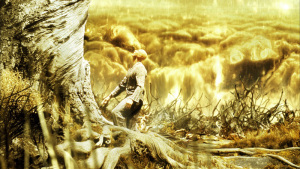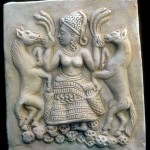Seek not, my soul, the life of the immortals;
but enjoy to the full the resources that are within thy reach.
— Pindar
Last night, before I did my ritual, I felt strongly compelled to watch Darren Aronofsky’s movie, “The Fountain”, again. It’s my favorite movie and is almost a religious experience for me to watch it. One part stuck with me; it’s actually the theme of the whole movie: “death as an act of creation”.

(Here are some stills from the movie.)
That is what Paganism is all about for me. It is the answer to that part of me which is a product of my (Mormon) Christian upbringing, which reifies the ego-self by calling it “spirit” and makes the immortality of that spirit the ultimate purpose of our lives. That same part of me that dreads death and gives birth to all kinds of unhealthy habits for avoiding the confrontation with the fact that I am going to die.
Now a lot of Pagans subscribe to the concept of reincarnation, and often it seems to take similar form as Christian eschatology: they say we have a spirit inside our body and it will survive the death of the body and enter another body. I accept reincarnation as a possibility (maybe it happens to some people but not others), but I don’t think it is the ego-self which would pass from one body to the next, but something more fundamental instead. I prefer the term “soul” (Greek psyche) to “spirit”, because it is harder to confuse the soul with the ego-self.
Some Pagans even believe in a version of heaven: the Summerland, where spirits go to await their next incarnation. To me, that seems like Christianity in Pagan disguise. When I told my (non-Pagan) wife about the idea of the Summerland, she remarked that it would make more sense, in the Pagan worldview, if such a place were called “Winterland”. And she is right: after all, Pagans associate winter and darkness, not summer and light, with death and rest.
Anyway, I came up with these two categories to describe these two different eschatologies: athanasia (without-death) and palingenesis (birth-again). The former, athanasia/deathlessness, is a Greek word applied to the gods, to distinguish them from mortals. The latter, palingenesis, Joseph Campbell defines as the “eternal recurrence of birth”. Often it is used to described literal reincarnation, but others (like Campbell, and the Cambridge Ritualists, Francis Cornford and Jane Ellen Harrison, for example), use it in the sense of “death as an act of creation” — death as birth.
Here is Jane Ellen Harrison explaining athanasia of the Greek Olympian gods in her book, Themis:
“The crowning disability and curse of the new theological order is that the Olympian claims to be immortal (athanatos). … All this, all life and that which is life and reality — Change and Movement — the Olympian renounces. Instead he chooses Deathlessness and Immutability — a seeming Immortality which is really the denial of life, for life is change. […] He will not be a daimon of Earth, nor yet even of the sky; above all he refuses to be a Year-daimon with his function of ceaseless toil. He will not rise again, but chooses instead a barren immortality. He withdraws himself from man and lives remote, a ‘jealous god’. … [T]he Olympian who will not die to live renounces life, he desiccates and dies. Such is the very nature of life that only through the ceaseless movement and rhythm of palingesesia is immortality possible. Athanasia, eternity through not dying, is almost a contradiction of words.”
In contrast, says Harrison, the Year-daimon (Frazier’s dying god) lives that he might die and dies that he might live. He “stands not for personal immortality in our modern sense, not for the negation of death, athanasia, but for the perennial renewal of life through death, for Reincarnation, for paligenesia.”
This, for me, is the quintessential theme of Paganism. It says to me: “You are going to die, just like everything else. Your body and the energy which animates it will return to where they came from — to the earth, to the physical universe. And you will live on only in the genes of your children and in the lives of those who you have touched and whom they will touch.” And to live fully in that awareness is, for me, a truly Pagan consciousness:
As Teilhard de Chardin writes:
“The world (its value, its infallibility and its goodness) – that, when all is said and done, is the first, the last, and the only thing in which I believe. It is by this faith that I live. And it is to this faith, I feel, that at the moment of death, rising above all doubts, I shall surrender myself.”
But last night, as I was watching “The Fountain”, I wondered: “How can I make my death an act of creation?” I can plant a tree over my remains, of course. But is there a more profound experience to be had.
I can illustrate my question by contrasting two different versions of the Wheel of the Year. There are many versions of the myth of the Wheel of the Year, and they all have a slightly different take on this theme of palingenesis. The one I have followed is this:
The god is born on the winter solstice, is fostered at mid-winter (Imbolc), mates with the Goddess at the spring equinox, marries her at mid-spring (Beltane), consummates their love at the summer solstice (at which time his dark twin is born), is consumed by the the fire of their passion at mid-summer (Lughnasadh), is reaped by the Goddess or the dark twin at the autumn equinox, and descends to the underworld at mid-autumn (Samhain), to be reborn again at the winter solstice. The dark twin follows the same pattern in reverse, sowing the seeds of his own rebirth at the autumn equinox, and being defeated by his light twin at the spring equinox.
Another version of the Wheel of the Year sets both the god’s dying and his dark twin’s rebirth at the summer solstice, and the dark god’s dying and his light twin’s rebirth at the winter solstice. The god plants the seeds of his own rebirth and dies in the same act. This latter version joins the deaths of the equinoxes to the births of the solstices.
What does all of this mean for me? The fact that I follow the former version, which separates the deaths of the equinoxes from the births of the solstices, reflects the fact that I do not know how to make of my death an act of creation. I understand living on through our children. But pro-creating my children did not require me to die (unless you consider the petite mort of orgasm a kind of death of the ego-self). It is no coincidence that I am asking this question in my mid-thirties, possibly the mid-point in my life, when my children are half grown.
I don’t presume to have an answer, but I came to the conclusion that the impetus I felt to watch the movie was not accidental. In my last post, I copied a quote from Joseph Campbell about union with God. And I wonder if my answer does not lie in there somewhere. Is it possible I would be given the answer before I had the question? I am going to be meditating on this during the rest of my Descensus Averni ritual.















